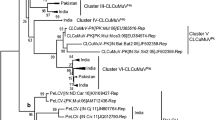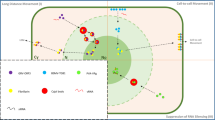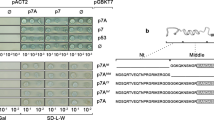Abstract
The replication of the geminiviruses depends on the viral encoded early (complementary-sense) proteins and on host genome encoded factors. Additionally, some of the early proteins (the AL2 protein of subgroup III, and the RepA (formerly known as C1) or Rep (C1:C2) proteins of subgroup I geminiviruses) can function as transcriptional activators of virion- (V-)sense gene expression. The yeast two-hybrid system has allowed us to predict some of the functionally important regions of the maize streak virus (MSV) early proteins RepA and Rep. Defined domains of these proteins were shown to act as transactivators in yeast cells. We detected the association of the RepA and Rep proteins, and their subfragments, with the maize retinoblastoma protein (ZmRb1) which is likely to be one of the interacting host proteins. We showed the self-association capability of the MSV proteins and suggest that homo- or hetero-oligomerization may play an important role in virus replication. These results provide new insights into the role of different regions of the MSV proteins in relation to transcriptional activation and regulation of viral DNA replication.
Similar content being viewed by others
References
Accotto G-P, Donson J, Mullineaux PM: Mapping of Digitaria streak virus transcripts reveals different RNA species from the same transcription unit. EMBO J 8: 1033–1039 (1989).
Bartel PL, Chien C-T, Sternglanz R, Fields S: Using the two-hybrid system to detect protein-protein interactions. In: Hartley DA (ed) Cellular Interactions in Development: A Practical Approach, pp. 153–179. Oxford University Press, Oxford (1993).
Boulton MI, King DI, Donson J, Davies JW: Point substitutions in a promoter-like region and the V1 gene affect the host range and symptoms of maize streak virus. Virology 183: 114–121 (1991).
Chou PY, Fasman GD: Empirical predictions of protein conformation. Annu Rev Biochem 47: 251–276 (1978).
Collin S, Fernández-Lobato M, Gooding PS, Mullineaux PM, Fenoll C: The two nonstructural proteins from wheat dwarf virus involved in viral gene expression and replication are retinoblastoma-binding proteins. Virology 219: 324–329 (1996).
Dekker EL, Woolston CJ, Xue Y, Cox B, Mullineaux PM: Transcript mapping reveals different expression strategies for the bicistronic RNAs of the geminivirus wheat dwarf virus. Nucl Acids Res 19: 4075–4081 (1991).
Desbiez C, David C, Mettouchi A, Laufs J, Gronenborn B: Rep protein of tomato yellow leaf curl geminivirus has an ATPase activity required for viral DNA replication. Proc Natl Acad Sci USA 92: 5640–5644 (1995).
Durfee T, Becherer K, Chen P, Yeh S, Yang Y, Kilburn AE, Lee W, Elledge SJ: The retinoblastoma protein associates with the protein phosphatase type 1 catalytic subunit. Genes Devel 7: 555–569 (1993).
Elmer JS, Brand L, Sunter G, Gardiner WE, Bisaro DM, Rogers SG: Genetic analysis of the tomato golden mosaic virus II. The product of the AL1 coding sequence is required for replication. Nucl Acids Res 16: 7043–7060 (1988).
Feilotter HE, Hannon GJ, Ruddel CJ, Beach D: Construction of an improved host strain for two-hybrid screening. Nucl Acids Res 22: 1502–1503 (1994).
Fontes EPB, Eagle PA, Sipe PS, Luckow VA, Hanley-Bowdoin L: Interaction between a geminivirus replication protein and origin DNA is essential for viral replication. J Biol Chem 11: 8459–8465 (1994).
Foster R, Izawa T, Chua N: Plant bZIP proteins gather at ACGT elements. FASEB J 8: 192–200 (1994).
Garnier J, Osguthorpe DJ, Robson B: Analysis of the accuracy and implications of simple methods for predicting the secondary structure of globular proteins. J Mol Biol 120: 97–120 (1978).
Goff SA, Cone KC, Chandler VL: Functional analysis of the transcriptional activator encoded by the maize B gene: evidence for a direct functional interaction between two classes of regulatory proteins. Genes Devel 6: 864–875 (1992).
Goff SA, Cone KC, Fromm ME: Identification of functional domains in the maize transcriptional activator C1: comparison of wild type and dominant inhibitor proteins. Genes Devel 5: 298–309 (1991).
Grafi G, Burnett RJ, Helentjaris T, Larkins BA, DeCaprio JA, Sellers WR, Kaelin WGJ: A maize cDNA encoding a member of the retinoblastoma protein family: Involvement in endoreduplication. Proc Natl Acad Sci USA 93: 8962–8967 (1996).
Hahn S: Structure (?) and function of acidic transcription activators. Cell 72: 481–483 (1993).
Haley A, Zhan X, Richardson KA, Head K, Morris BAM: Regulation of the activities of African cassava mosaic virus promoters by the AC1, AC2 and AC3 gene products. Virology 188: 905–909 (1992).
Heyraud-Nitschke F, Schumacher S, Laufs J, Schaefer S, Schell J, Gronenborn B: Determination of the origin cleavage and joining domain of geminivirus Rep proteins. Nucl Acids Res 23: 910–916 (1995).
Hofer JMI, Dekker EL, Reynolds HV, Woolston CJ, Cox BS, Mullineaux PM: Coordinate regulation of replication and virion sense gene expression in wheat dwarf virus. Plant Cell 4: 213–223 (1992).
Hong Y, Stanley J: Regulation of African cassava mosaic virus complementary-sense gene expression by N-terminal sequences of the replication-associated protein AC1. J Gen Virol 76: 2415–2422 (1995).
Jupin I, Hericourt F, Benz B, Gronenborn B: DNA replication specificity of TYLCV geminivirus is mediated by the aminoterminal 116 amino acids of the Rep protein. FEBS Lett 362: 116–120 (1995).
Laglands K, Prochownik EV: A rapid method for the preparation of yeast lysates that facilitates the immunodetection of proteins generated by the yeast two-hybrid system. Anal Biochem 249: 250–252 (1997).
Lee W, Shew JY, Hong FD, Sery TW, Donoso LA, Young L, Bookstein R, Lee E: The retinoblastoma susceptibility gene encodes a nuclear phosphoprotein associated with DNAbinding activity. Nature 329: 642–645 (1987).
Leuther KK, Salmeron JM, Johnston SA: Genetic evidence that an activation domain of GAL4 does not require acidity and may form a β sheet. Cell 72: 575–585 (1993).
Li X, Green MR: Intramolecular inhibition of activating transcription factor-2 function by its DNA-binding domain. Genes Devel 10: 517–527 (1996).
Mullineaux PM, Donson J, Morris-Krsinich BAM, Boulton MI, Davies JW: The nucleotide sequence of maize streak virus DNA. EMBO J 3: 3063–3068 (1984).
Mullineaux PM, Guerineau F, Accotto G-P: Processing of complementary sense RNAs of Digitaria streak virus in its host and in transgenic tobacco. Nucl Acids Res 18: 7259–7265 (1990).
Nagar S, Pedersen TJ, Carrick K, Hanley-Bowdoin L, Robertson D: A geminivirus induces expression of a host DNA replication protein in terminally differentiated plant cells. Plant Cell 7: 705–719 (1995).
Parker W, Song P: Location of helical regions in tetrapyrrolecontaining proteins by a helical hydrophobic moment analysis. J Biol Chem 265: 17568–17575 (1990).
Rabindran SK, Haroun RI, Clos J, Wisniewski J, Wu C: Regulation of heat shock factor trimer formation: role of a conserved leucine zipper. Science 259: 230–234 (1993).
Rose GD: Prediction of chain turns in globular proteins on a hydrophobic basis. Nature 272: 586–590 (1978).
Sambrook J, Fritsch EF, Maniatis T: Molecular Cloning: A Laboratory Manual, 2nd ed. Cold Spring Harbor Laboratory Press, Cold Spring Harbor, NY (1989).
Saunders K, Lucy A, Stanley J: DNA forms of the geminivirus African cassava mosaic virus consistent with a rolling circle mechanism of replication. Nucl Acids Res 19: 2325–2330 (1991).
Schalk H-J, Matzeit V, Schiller B, Schell J, Gronenborn B: Wheat dwarf virus, a geminivirus of graminaceous plants needs splicing for replication. EMBO J 8: 359–364 (1989).
Schiestl RH, Gietz D: High efficiency transformation of intact yeast cells using single stranded nucleic acids as a carrier. Curr Genet 16: 339–346 (1989).
Schneider S, Buchert M, Hovens CM: An in vitro assay of β-galactosidase from yeast. BioTechniques 20: 960–962 (1996).
Settlage SB, Miller AB, Hanley-Bowdoin L: Interactions between geminivirus replication proteins. J Virol 70: 6790–6795 (1996).
Sheldon LA, Kingston RE: Hydrophobic coiled coil domains regulate the subcellular localization of human heat shock factor 2. Genes Devel 7: 1549–1558 (1993).
Staudinger J, Perry M, Elledge SJ, Olson EN: Interactions among vertebrate helix-loop-helix proteins in yeast using the two-hybrid system. J Biol Chem 268: 4608–4611 (1993).
Stenger DC, Revington GN, Stevenson MC, Bisaro DM: Replicational release of geminivirus genomes from tandemly repeated copies: evidence for rolling-circle replication of a plant viral DNA. Proc Natl Acad Sci USA 88: 8029–8033 (1991).
Struhl K: Molecular mechanisms of transcriptional regulation in yeast. Annu Rev Biochem 58: 1051–1077 (1989).
Struhl K: Yeast transcriptional regulatory mechanisms. Annu Rev Genet 29: 651–674 (1995).
Sunter G, Bisaro DM: Transactivation in a geminivirus: AL2 gene product is needed for coat protein expression. Virology 180: 416–419 (1991).
Sunter G, Bisaro DM: Transactivation of geminivirus AR1 and BR1 gene expression by the viral AL2 gene product occurs at the level of transcription. Plant Cell 4: 1321–1331 (1992).
Sunter G, Hartitz MD, Bisaro DM: Tomato golden mosaic virus leftward gene expression: autoregulation of geminivirus replication protein. Virology 195: 275–280 (1993).
Timmermans MCP, Das OP, Messing J: Geminiviruses and their uses as extrachromosomal replicons. Annu Rev Plant Physiol Plant Mol Biol 45: 79–112 (1994).
Tommasino M, Crawford L: Human Papillomavirus E6 and E7: proteins which deregulate the cell cycle. BioEssays 17: 509–518 (1997).
Van Hoy M, Leuther KK, Kodadek T, Johnston SA: The acidic activation domains of the GCN4 and GAL4 proteins are not α helical but form β-sheets. Cell 72: 587–594 (1993).
Vousden K: Interactions of human papillomavirus transforming proteins with the products of tumor suppressor genes. FASEB J 7: 872–879 (1993).
Wiman KG: The retinoblastoma gene: role in cell cycle control and cell differentiation. FASEB J 7: 841–845 (1993).
Wright E, Heckel T, Groenendijk J, Davies JW, Boulton MI: Splicing features in maize streak virus virion-and complementary-sense gene expression. Plant J 12: 1285–1297 (1997)
Xie Q, Sanz-Burgos A, Hannon GJ, Gutiérrez C: Plant cells contain a novel member of the retinoblastoma family of growth regulatory proteins. EMBO J 15: 4900–4908 (1996).
Xie Q, Suárez-López P, Gutiérrez C: Identification and analysis of a retinoblastoma binding motif in the replication protein of a plant DNA virus: requirement for efficient viral DNA replication. EMBO J 14: 4073–4082 (1995).
Yang M, Wu Z, Fields S: Protein-peptide interactions analyzed with the yeast two-hybrid system. Nucl Acids Res 23: 1152–1156 (1995).
Zhan X, Richardson KA, Haley A, Morris BAM: The activity of the coat protein promoter of chloris striate mosaic virus is enhanced by its own and C1-C2 gene products. Virology 193: 498–502 (1993).
Zhou J, Olson EN: Dimerization through the helix-loop-helix motif enhances phosphorylation of the transcription activation domains of myogenin. Mol Cell Biol 14: 6232–6243 (1994).
Author information
Authors and Affiliations
Rights and permissions
About this article
Cite this article
Horváth, G.V., Pettkó-Szandtner, A., Nikovics, K. et al. Prediction of functional regions of the maize streak virus replication-associated proteins by protein-protein interaction analysis. Plant Mol Biol 38, 699–712 (1998). https://doi.org/10.1023/A:1006076316887
Issue Date:
DOI: https://doi.org/10.1023/A:1006076316887




